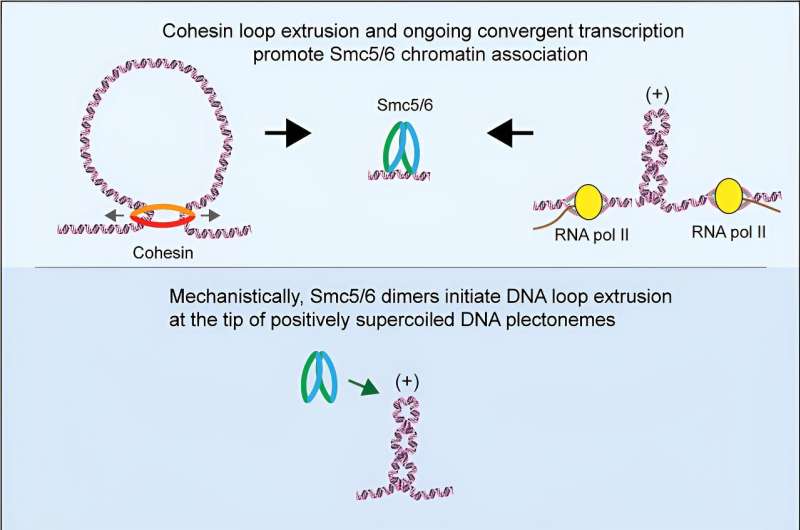This article has been reviewed according to Science X's editorial process and policies. Editors have highlighted the following attributes while ensuring the content's credibility:
fact-checked
trusted source
proofread
Gene expression influences 3D folding of chromosomes by altering structure of the DNA helix, finds study

A collaborative study by the UTokyo-KI LINK program, headed by Camilla Björkegren from Karolinska Institutet, Kristian Jeppsson and Katsuhiko Shirahige from The University of Tokyo shows that a protein complex named Smc5/6 binds DNA structures called positive supercoils. These form when the chromosomal DNA double helix folds onto itself due to overtwisting caused by transcription, which is the first step in gene expression.
The study presents in vivo data indicating that Smc5/6 binds to the base of chromosome loops in regions that contain high levels of transcription-induced positive supercoils. The complex is also shown to control the three-dimensional (3D) organization of these regions.
Computational machine learning provides additional results supporting that transcription-induced positive supercoils determine the chromosomal binding pattern of Smc5/6. Finally, in vitro single molecule analysis, performed by the team of Dr. Eugene Kim at Max Planck Institute in Frankfurt, provides direct evidence that Smc5/6 preferentially binds positive DNA supercoils.
Taken together, the analysis reveals that gene expression influences the spatial arrangement of chromosomes by changing the structure of the DNA helix, and thereby triggering the association of Smc5/6. The study is published in the journal Molecular Cell.
Since the 3D organization of chromosomes influences cell function and survival, the findings are important for our basic understanding of life. Intriguingly, the 3D organization of chromosomes can also control gene expression, suggesting a dynamic feedback loop between the two processes, mediated by positive supercoils and Smc5/6. Moreover, since Smc5/6 inhibits replication of several viruses, and mutated versions of the complex are connected to developmental defects and tumor formation, the knowledge obtained is relevant also in a medical perspective.
"We now aim to further investigate the functional consequences of our new findings, particularly how they relate to Smc5/6's role in viral protection, development, and tumor prevention" says Björkegren.
More information: Kristian Jeppsson et al, Loop-extruding Smc5/6 organizes transcription-induced positive DNA supercoils, Molecular Cell (2024). DOI: 10.1016/j.molcel.2024.01.005
Provided by Karolinska Institutet





















